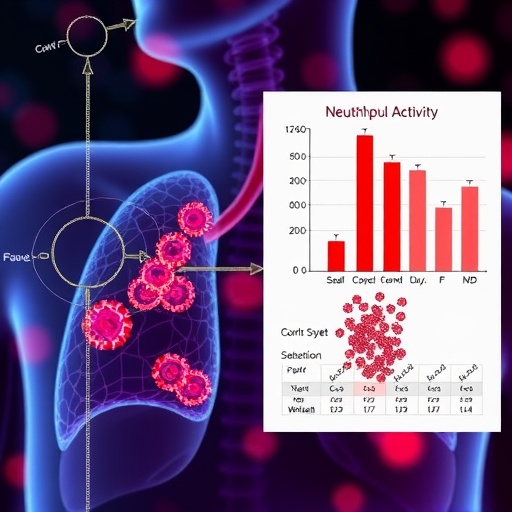In a groundbreaking study published in BioMedical Engineering OnLine, researchers have unveiled novel insights into the complex immune and metabolic interactions present in patients suffering from chronic obstructive pulmonary disease (COPD) complicated by metabolic syndrome (MS). This dual pathology, which exacerbates patient morbidity, has long posed challenges in clinical management. The latest research harnesses the power of transcriptomic and metabolomic analyses to decode the intricacies of neutrophil activity — a pivotal component of the innate immune response — shedding light on potential therapeutic targets to better tackle this debilitating combination of diseases.
COPD, a progressive lung disease characterized by persistent airflow limitation, is often aggravated by coexisting metabolic syndrome, a cluster of conditions including obesity, insulin resistance, hypertension, and dyslipidemia. This coexistence is notorious for amplifying systemic inflammation and accelerating disease progression, yet the molecular underpinnings have remained poorly understood. By scrutinizing a large cohort of over 11,000 COPD patients treated at a major respiratory care hospital in Chengdu over a decade, the research team laid the groundwork for an in-depth mechanistic investigation into how metabolic alterations interplay with immune dysfunction in these patients.
A subset of 30 patients from this expansive cohort underwent intensive molecular profiling. Through simultaneous transcriptomic and metabolomic scrutiny of their blood samples, investigators sought to dissect the differences in immune signaling and metabolic pathways between COPD patients with and without metabolic syndrome. Transcriptomics, which profiles gene expression patterns, enabled the identification of key immune genes involved in disease exacerbation, while metabolomics provided a snapshot of small molecule metabolites that reflect cellular processes and metabolic shifts at the systemic level.
The results were compelling. Transcriptomic analyses highlighted 327 differentially expressed genes prominently enriched in neutrophil-related immune pathways. Neutrophils, the most abundant circulating white blood cells, are first responders to inflammation and infection. Their hyperactivation in COPD–MS patients signals an exaggerated innate immune response, which can contribute to tissue damage, chronic inflammation, and impaired lung function. This hyperactivity was reflected in the altered genetic signature favoring neutrophil recruitment, activation, and degranulation processes.
Simultaneously, metabolomic profiling uncovered 39 metabolites that were significantly altered in patients with the dual diagnosis. Among these, L-homoarginine and diethanolamine stood out due to their elevated plasma concentrations and strong correlations with neutrophil-associated gene expression. L-homoarginine, an analog of arginine involved in nitric oxide metabolism, may influence vascular inflammation and endothelial function, while diethanolamine, a derivative linked to lipid metabolism alterations, potentially modulates immune cell signaling. These metabolite perturbations suggest a metabolic reprogramming that accompanies and possibly drives the augmented neutrophilic inflammation observed.
The study further revealed immune polarization shifts at the cytokine level with decreased expression of IL4 and IL5RA observed in COPD–MS patients. These molecules are integral to Th2-type immune responses, which typically promote anti-inflammatory and tissue repair processes. Their downregulation hints toward a skewing from Th2 toward Th1-dominant inflammatory pathways, notorious for fostering chronic, unresolved inflammation. This shift may explain, in part, the resistance to glucocorticoid therapies frequently encountered in severe COPD cases complicated by metabolic syndrome.
Importantly, the intertwined metabolic and immune alterations delineated in this research underscore a feedback loop wherein disturbed metabolism amplifies neutrophil-mediated inflammation, which in turn perpetuates metabolic derangements. This vicious cycle intensifies tissue damage and exacerbates airflow limitation, culminating in worsened patient outcomes. Recognizing this reciprocal relationship opens new avenues for intervention, proposing that simultaneous targeting of immune dysregulation and metabolic imbalance could yield superior therapeutic efficacy.
The methodology employed by the researchers exemplifies the power of integrating high-throughput omics technologies to unravel complex disease mechanisms. By leveraging multivariate logistic regression analyses across a vast clinical dataset combined with molecular profiling of a carefully selected subset, the study bridges epidemiological findings with mechanistic insights, enhancing translational relevance. Such a comprehensive approach is critical for diseases like COPD–MS, where heterogeneous patient presentations and comorbidities complicate standardized treatment protocols.
This study also raises critical questions for future research. For instance, the role of specific metabolic alterations such as elevated L-homoarginine in modulating neutrophil function warrants deeper exploration. Could manipulating these metabolic pathways restore immune balance or sensitize resistant patients to conventional anti-inflammatory treatments? Furthermore, the identified differential gene expression patterns provide a rich resource for biomarker development, potentially enabling early identification of COPD patients at risk of metabolic complications or exacerbations.
From a clinical perspective, these findings advocate for a more personalized management strategy in COPD patients with metabolic syndrome. Routine evaluation of metabolic parameters alongside immunoprofiling could identify patients who would benefit from combined metabolic and immunomodulatory therapies. This integrated approach may help mitigate the detrimental impacts of chronic inflammation and metabolic dysfunction, ultimately improving quality of life and reducing hospitalizations.
The broader implications of this research extend beyond COPD alone, highlighting a paradigm applicable to other chronic inflammatory diseases compounded by metabolic disturbances. The interplay between metabolism and immunity, a rapidly evolving field known as immunometabolism, presents promising therapeutic targets that are being actively investigated across various disciplines. As such, this study contributes valuable insights and a solid framework for future endeavors.
In conclusion, the transcriptomic and metabolomic dissection of neutrophil activity in COPD patients complicated by metabolic syndrome marks a significant advance in understanding the pathophysiological interplay driving disease severity. By spotlighting the enhanced neutrophil-mediated inflammatory response coupled with distinct metabolic dysfunction, the research paves the way for innovative therapeutic interventions that could disrupt this pathogenic nexus. The findings resonate deeply within the medical community eager for precision medicine solutions for complex chronic diseases, marking a pivotal step towards more effective, tailored COPD care.
Subject of Research: Immune and metabolic response characteristics in COPD complicated by metabolic syndrome, focusing on neutrophil activity.
Article Title: Transcriptomic and metabolomic insights into neutrophil activity in COPD complicated by metabolic syndrome.
Article References:
Li, J., Wu, X., Fu, Y. et al. Transcriptomic and metabolomic insights into neutrophil activity in COPD complicated by metabolic syndrome. BioMed Eng OnLine 24, 43 (2025). https://doi.org/10.1186/s12938-025-01378-5
Image Credits: AI Generated




